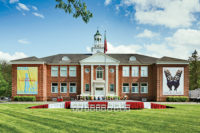The Modules
Out of the Box: The Modules, a student housing development by Interface Studio Architects, flaunts its construction method as it makes a case for well-designed prefab.






























Architects & Firms
Philadelphia, Pennsylvania
The Modules want you to know how they were built. A privately owned student apartment building a few blocks from Temple University’s campus in North Philadelphia, the project touts its prefabricated construction in its branding: In its lobby and lounges, photomurals show a construction crane neatly stacking the 90 boxes that house its 72 units. “Prefab isn’t something that needs to be invisible,” says Brian Phillips of Interface Studio Architects, who designed the project. “It’s something that adds real value that people should understand.”
The firm and its client decided to celebrate the four-story, 80,000-square-foot building’s origins because, they say, it makes a strong case for prefab in urban contexts. Like many cities, Philadelphia has notoriously high construction costs and a soft rental market still reeling from the recession. Manufacturing the Modules’ components outside the city saved on labor expenditures, while simultaneously building the structure’s concrete-and-steel plinth shortened the time line. The firm went from the early design phase to occupancy in about 14 months, delivering a building that cost $137 per square foot in time for the next academic year. “This is not one of those ornamental modular projects that have intellectual appeal but are very expensive,” says Phillips. “We needed efficiencies, so we used the same technology as prefab buildings everywhere.”
Interface began by selecting modular manufacturer IDBS and learning the limitations of its timber-frame components. A residential unit with a comfortably sized, if unremarkable, living room, bedroom, kitchen, and bath was 16 feet wide and either 30 or 55 feet in length. The ceiling height capped at 10 feet so the components would fit under bridges along the 136-mile route from the factory in Liverpool, Pennsylvania, to the site. The modules arrived with plumbing and wiring installed and interiors almost completely finished.
The firm stacked the boxes, creating a mirrored E shape in plan to maximize access to daylight inside the apartments. Narrow hallways stitch together the component modules along an east-to-west spine, which connects the building’s two entries on the first floor. The east entry leads to a partially below-grade parking lot and a side street that provides a shortcut to campus. The firm used porous paving on sections of the lot, and above, they covered most of the roof with a three-inch sedum bed to comply with Philadelphia’s stringent stormwater laws. The water management scheme and simple heating and cooling systems—a central chiller plant and a water-source heat pump—that plugged easily into the modular units earned the project LEED Gold. The firm wrapped the bundle of prefab units in a rainscreen covered by fiber-cement panels. “It’s a pretty honest facade,” says Phillips. “You can adapt the entire building system to different conditions without totally reinventing it.”
But in the future, he adds, his firm will adhere to a modular orthodoxy: one apartment per prefab box. During the course of the project, combining some units in the field caused delays. The firm did manage to skirt high labor costs by going prefab, and Phillips says the success of their strategy raises questions about the viability of Philadelphia’s expensive construction pricing. It also demonstrates that prefab can be an opportunity to bring better design to “background buildings,” projects that require speed and economy but aren’t necessarily glamorous. “We didn’t do this because it’s cool to build stuff in a factory,” says Phillips. “This project might not have happened if it hadn’t been built prefab.”
Size: 80,000 sq.ft.
Construction cost: $11 million
Completion date: September 2010
Architect:
ISA – Interface Studio Architects LLC
1400 N American Street #301
Philadelphia, PA 19122
v. 215-232-1500
f. 215-232-1042
PeopleOwner: Carlisle Street Partners
Architect:
Personnel in architect's firm who should receive special credit: Principal: Daryn Edwards, AIA, LEED AP Project Architect: Viktoria Diskina, AIA, LEED AP Project Designers: Morgan Ellig; Jenni Tarner, AIA, LEED BD+C; Kara Medow; Deborah Grossberg Katz, LEED AP; V. Kemal Muskara; Andrew Waxtel
Engineer(s):
Consultant(s): Green Roof: Roofmeadow Other: Graphics / Branding: Die Creative, LLC General contractor: Equinox Management & Construction, LLC Photographer(s): Sam Oberter Photography, 215.850.5482 Renderer(s): ISA – Interface Studio Architects LLC CAD system, project management, or other software used: AutoCAD, Sketchup, Vray, Photoshop |
Products
Structural system
Manufacturer of structural components unique to this project:
Exterior cladding Metal/glass curtain wall: Storefront system: Kawneer
Rainscreen (terra cotta, composite, etc.): Precast concrete: Larry E. Knight, Inc. Moisture barrier: Typar (at stucco facades only) Other cladding unique to this project: Stucco, local
Roofing Tile/shingles: Hanover roof pavers
Windows
Doors Metal doors: Taylor (apartment unit doors) Wood doors: Masonite (bedroom / bathroom doors) Sliding doors: Masonite (closet doors) Upswinging doors, other: Overhead Door (Garage door)
Hardware Closers: Schlage Exit devices: Schlage Pulls: Schlage Security devices: Schlage
Interior finishes Paints and stains: Sherwin Williams Wall coverings: Murals Plastic laminate: Wilsonart Floor and wall tile: Daltile Resilient flooring: Toli vinyl plank (at residential unit interiors) Carpet: Nood (hallways)
Lighting Exterior: Prisma / Bega
Conveyance |



















